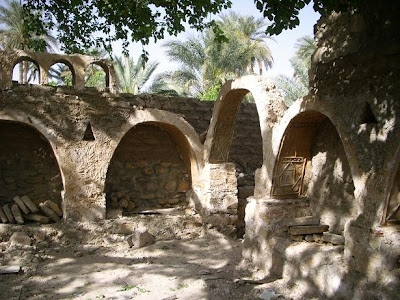Published on May 27th 2009
Ghadames (Arabic: غدامس) is a town in the south west of Libya. It is located about 550 km from Tripoli, near the Libyan borders with Algeria and Tunisia. The town has a population of about 22,000 people. The old city or old part of the town has been declared UNESCO World Heritage Site.
Each of the seven clans that used to live in this part of the town had its own district, of which each had a public place where festivals could be held and its own entrance gate. Each clan had its own slang and architectural signature such that one can recognize the district of a clan by its characteristic roofs and door front shapes.

 Ghadames is famous for its beautiful and inventive architecture, designed to fight the dramatic extremes in desert climate. Houses and all buildings are built with locally available building materials namely; mud, lime, and palm tree trunks. Between the buildings there are covered alleyways like an underground route. These routes are vented and illuminated with daylight by specially cut shafts.
Ghadames is famous for its beautiful and inventive architecture, designed to fight the dramatic extremes in desert climate. Houses and all buildings are built with locally available building materials namely; mud, lime, and palm tree trunks. Between the buildings there are covered alleyways like an underground route. These routes are vented and illuminated with daylight by specially cut shafts.
The first records about Ghadames date from the Roman era, when there were Roman troops in the town from time to time. The Romans called the town Cydamus, and this could be the origin of its current name.
During the 7th century, Ghadames was conquered by the Muslim Arabs who were lead by Uqba bin Nafi on his way to Tunisia. The population quickly accepted Islam and they played an important role in the propagation of Islam to Africa through trans-Saharan trade . The town was a valuable stopover on the caravan routes crossing the great Sahara desert. The old town houses the Ancient Mosque, which is the oldest existing mosque in Libya.
In the 1970s the Libyan government started a new housing project and by 1986 the whole population left the old town, but during the summer many of them go back to the coolness of their ancient buildings in the old town.
Recently the Libyan government established a special development authority for Ghadames responsible for rebuilding the old town in the same traditional way using the same building materials.
A face-lift up is being given to all the farms, streets, buildings, palm trees, and water resources.
In addition to the old town Ghadames offers other attractions like the views of the desert, especially at sunset, the salt lakes, not to mention camels.
Ghadames is well worth visiting for a few days. It has very good services, good facilities and very good tour guides.
Traditional building
Each of the seven clans that used to live in this part of the town had its own district, of which each had a public place where festivals could be held and its own entrance gate. Each clan had its own slang and architectural signature such that one can recognize the district of a clan by its characteristic roofs and door front shapes.
Toota square: a public place being rebuilt
Covered alleyways
The covered alleyways offer good shelter against sun’s heat during the summer while the walls are thick providing good thermal insulation.
The rooftops are made into pathways for the womenfolk to meet each other: normally men use the lower pathways, while women are rarely seen on there unless accompanied by their male relatives. A woman of Ghadames takes pride in decorating her house, an art she learns early from her mother.
Traditional decoration of a sitting room
Women normally play an important role in society and around the house because men would go away for months and sometimes years in trade or study or pilgrimage to Mecca
The entrance stone for a women’s prayer hall
Modern style housing
An entrance stone for the Ancient Mosque, built in 668
Water reservoir for Ain Alfarras, the main water source
Recently the Libyan government established a special development authority for Ghadames responsible for rebuilding the old town in the same traditional way using the same building materials.
Ain Alfarras hotel under renovation
A general view from the top of the Alwaha hotel
Rebuilt water channels
This project is expected to last for a few years with a lot of good results.In addition to the old town Ghadames offers other attractions like the views of the desert, especially at sunset, the salt lakes, not to mention camels.
Ghadames sand dunes
Ain Eddban salt lake
A baby camel a few weeks old
Spring in Ghadames is heralded by beautiful blooming flowers. Spring blooms with new life
















No comments:
Post a Comment